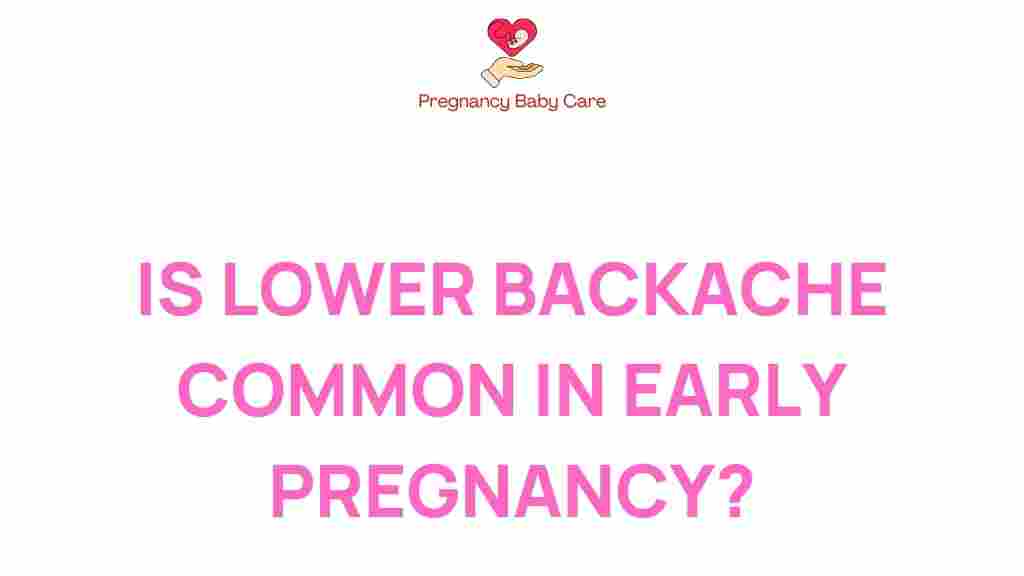Is Lower Backache a Common Indicator of Early Pregnancy?
Lower backache is a common discomfort that many women experience throughout their lives. However, for many expectant mothers, this symptom can take on a new significance when considering the possibility of early pregnancy. Understanding the connection between lower backache and early pregnancy is crucial for health awareness and ensuring proper prenatal care. In this article, we will explore the relationship between lower backache and early pregnancy, including common pregnancy symptoms, body changes, and what to expect during this exciting time.
Understanding Lower Backache in Early Pregnancy
Lower backache can be one of the many symptoms that signal the onset of early pregnancy. While it can be associated with various issues, its occurrence in conjunction with other pregnancy symptoms may indicate that conception has taken place. Here are some key points to consider:
- Hormonal Changes: Early pregnancy triggers a surge in hormones, primarily progesterone, which can lead to muscle relaxation and changes in posture, contributing to lower backache.
- Body Changes: As the body begins to accommodate the developing fetus, physical adjustments occur. These changes can put additional strain on the back.
- Increased Blood Volume: During pregnancy, the body generates more blood to support the fetus, which can lead to swelling and discomfort in various areas, including the lower back.
Common Pregnancy Symptoms Accompanying Lower Backache
While lower backache can be a standalone symptom, it is often accompanied by other signs of early pregnancy. Recognizing these symptoms can help you determine whether you might be expecting:
- Missed Period: One of the first indicators of pregnancy is a missed menstrual cycle.
- Nausea and Vomiting: Often referred to as morning sickness, this symptom can vary in intensity.
- Breast Changes: Tenderness, swelling, or changes in the areola can occur due to hormonal fluctuations.
- Fatigue: Increased tiredness is common in early pregnancy due to hormonal changes and the body’s increased energy demands.
- Frequent Urination: As the uterus expands, it can put pressure on the bladder, leading to more frequent bathroom trips.
Step-by-Step Process: Recognizing Early Pregnancy
If you are experiencing lower backache along with other symptoms, here’s a step-by-step process to help you determine if you might be in early pregnancy:
- Monitor Your Menstrual Cycle: Track your cycle and note if it’s late or missed.
- Observe Additional Symptoms: Take note of other pregnancy symptoms, such as nausea, breast tenderness, and fatigue.
- Take a Home Pregnancy Test: Purchase a home pregnancy test from a pharmacy and follow the instructions.
- Visit a Healthcare Provider: If the home test is positive or if you have any concerns, schedule an appointment for confirmation and prenatal care.
Health Awareness: The Importance of Prenatal Care
For expectant mothers, health awareness is key to a healthy pregnancy. Regular prenatal care is essential, and it helps monitor both the mother’s and baby’s health. Here are some benefits of prenatal care:
- Early Detection: Regular check-ups can identify potential health issues early on.
- Guidance and Education: Healthcare providers offer valuable advice on nutrition, exercise, and managing discomfort, including lower backache.
- Emotional Support: Pregnancy can be an emotional time; prenatal visits provide an opportunity to discuss feelings and concerns.
Troubleshooting Lower Backache During Early Pregnancy
Lower backache can be uncomfortable, but there are several strategies that expectant mothers can use to manage this symptom effectively:
- Practice Good Posture: Maintaining proper posture can alleviate pressure on the lower back.
- Use Supportive Pillows: When sleeping, use pillows to support your back and abdomen.
- Gentle Stretching: Engage in gentle stretches and prenatal yoga to relax muscles and improve flexibility.
- Stay Active: Light exercise, such as walking, can help strengthen back muscles and reduce discomfort.
- Heat Therapy: Applying heat to the lower back can soothe aching muscles.
Consulting Healthcare Professionals
If lower backache persists or is severe, it is crucial to consult a healthcare professional. They can assess the situation and provide tailored advice for managing discomfort during early pregnancy. You can find more information about prenatal care and common pregnancy symptoms at ACOG.
Conclusion
In conclusion, lower backache is indeed a common indicator of early pregnancy, particularly when it occurs alongside other pregnancy symptoms. Understanding the body changes that occur during this period is essential for expectant mothers. By being aware of your body and seeking proper prenatal care, you can better navigate the challenges of early pregnancy. If you experience persistent discomfort or have concerns, always consult a healthcare provider for personalized advice and support.
For additional resources on managing discomfort and understanding pregnancy symptoms, feel free to check out our other articles on health awareness.
This article is in the category Pregnancy and created by PregnancyBabyCare Team
